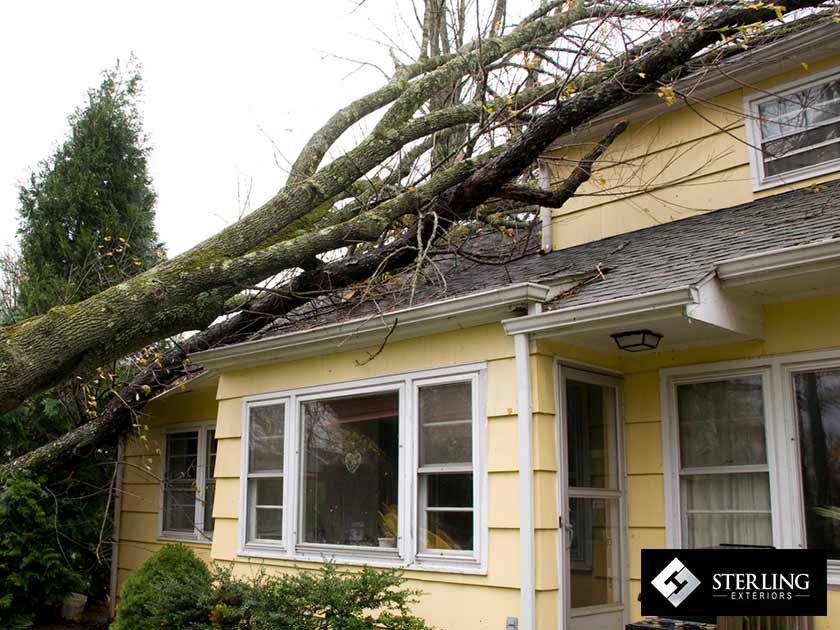Roof debris is more than just an eyesore when seen from the curb; it can also inflict damage in many different ways. Some accumulate on the surface and slowly weaken the whole structure, while others create a big impact strong enough to leave dents, punctures or dents before falling off. If not dealt with properly, you may be looking at a problem that is expensive to fix.

In this blog, Sterling Exteriors takes a closer look at the worst types of debris that can land on your roofing system, as well as ways on how to deal with them.
Building Materials
Hurricane-type winds can cause roof damage because they can get under the roofing materials and lift them up until they pull away from their attachments. These winds are also capable of tearing or blowing asphalt shingles or metal panels off the roof structure. What’s more concerning, however, is the fact that they can pick up debris made of items people often use every day and send them flying before colliding with the roof surface.
Materials such as antennas, fences, posts, outdoor furniture and roofing components from neighboring houses can become high-speed projectiles during such occurrences. That’s enough to leave a significant and noticeable mark on your roof, which is why you must get in touch with your local roofing company as soon as the storm has died down. They can perform a comprehensive roof inspection to assess the extent of the damage. From there, the experienced roofers can recommend the most appropriate solutions to issues they uncovered.
Hail
The extent and severity of the roofing damage caused by hailstones depend on several factors. One of them is the shape of hail. We know that hailstones are usually round, but there are others that are irregularly shaped. This can affect the amount of energy transferred to the roofing material upon impact, also known as “impact energy.” A hailstone with a narrow end hits the roof with more force, increasing the potential for damage.
The size of the hailstone is another factor. The larger it is, the more impact energy it brings. It also falls faster from the sky than a smaller one. However, the likelihood of damage is based on the angle of impact and the density of the hailstone. Some are compact and can pack a punch when they hit the roof, but others tend to be softer and lighter due to the air bubbles underneath all the layers of ice.
Like wind-borne debris, hailstones can inflict damage on your roof. In addition to cracks, heavier and denser hailstones can knock off the asphalt shingle’s protective granules. This expedites the wear and tear of the roof, shortening its lifespan and compromising its ability to withstand the elements. If not addressed right away, the elements can further worsen the damage. Moisture, in particular, can seep through the roof surface, resulting in leaks.
Storm damage repair is imperative to ensure your roof can continue delivering great weather performance. However, if your hail-damaged roof needs to be replaced based on your roofing contractor’s recommendations, it would be wise to invest in high-quality roofing materials that have been tested and proven to provide superior impact resistance.
Tree Branches
Trees planted around your property provide shade during the summer months and enhance your home’s curb appeal. However, they can pose a threat if they’re planted too close to your roof. Strong winds can break their branches right off during an intense storm, causing them to crash on top of your home. Anything heavy falling from a considerable height and landing on the surface of your roof can lead to damage, particularly shingle tears and punctures.
Even when there’s no storm, a gust of wind can bend and whip overhanging branches across the roof surface repeatedly. As they sway, the leaves and twigs rub against the shingles, dislodging the granules and causing noticeable damage. However, the worst thing that could happen during a severe storm is when an old or unsupported tree falls and crashes on your roof, creating large openings where precipitation can infiltrate.
Fortunately, roof damage caused by trees can be prevented with some preemptive measures. If one of the trees near your home has branches that extend to your roof, consider trimming them back. Be sure the tip is at least six feet away from your home’s exteriors. Alternatively, you can have trees planted too close to your home removed. They may provide shade in the summer, but it may also not be worth the potential need for roof repair and restoration work involved with them still standing.
Organic Debris
Roofing systems tend to accumulate leaves, pine needles, and other loose organic debris over time. Leaving them there for too long can risk more than stained shingles. They hold water, wind-blown soil, and decaying material that can cause early wear and failure of the roofing material. With moisture present, actual plant growth is possible in the form of moss. It also permits freeze-thaw cycle damage, especially during the colder months.
Clogs inside gutter systems are also a problem when there’s organic debris on your roof. The longer they stay there, the less likely it is for your gutters to perform their function of catching rainwater runoff and directing it away from your property. During a heavy downpour, water starts to flow out to the sides of the gutters and affects your home’s exterior components, landscaping and foundations.
Apart from trimming back overhanging branches, making sure your roof is clean is imperative. Investing in such can reduce the potential of these issues from occurring. Installing a gutter protection system also helps if you aren’t too keen on keeping up with the seasonal home maintenance task of cleaning your gutters.
Keeping your roofing system in good condition is the key to mitigating the potential damage these types of debris can cause. Scheduling inspections and maintenance at least twice a year is recommended to ensure its longevity, durability and weather performance. However, when disaster strikes and your roof suffers damage, you shouldn’t delay much-needed repairs. Get in touch with Sterling Exteriors immediately for a quick response to stop leaks, prevent further damage and restore your roof’s ability to protect your home and your family.
Call (513) 496-0976 or fill out our contact form to get a free quote. We serve homeowners in Newtown, Loveland, and Cincinnati, OH.






